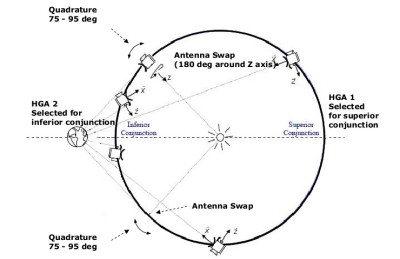Quadrature operations on Venus Express
Quadrature phases are periods of about 5 weeks during which the Sun-spacecraft-Earth angle is between 75 degrees and 95 degrees. They occur twice in every synodical period of Venus (584 days, or about 19 months), with an inbound quadrature phase - when Venus gets closer to Earth - ending 9 weeks before a Venus inferior conjunction and an outbound quadrature phase - when Venus recedes from Earth - starting 9 weeks after the inferior conjunction.
 |
|
Schematic diagram showing antenna selection during quadrature operation. Credit: ESA |
Two critical activities must take place during quadrature phases, both of which are related to management of solar illumination on normally cold spacecraft faces:
-
Biasing the spacecraft attitude when pointing towards Earth to avoid the intrusion of solar radiation into the Venus Monitoring Camera's (VMC) field-of-view
The spacecraft attitude must be biased when pointing towards Earth for about two weeks before and after quadrature, when the Sun-spacecraft-Earth angle is between 75 and 95 degrees. This avoids exposure of the VMC's sensitive components to the Sun, and continuously illuminates the +Y face (normally a cold spacecraft face) during Earth communications, at a 10 degree solar aspect angle (SAA). This biasing is achieved by uploading a 'fake Ephemeris', which tricks the spacecraft into registering that it is pointing somewhere else, and results in the desired attitude. This biased attitude must be maintained for the duration of the quadrature phase.
Thermal constraints have been defined by the spacecraft manufacturer, which result in significant limitations on routine science operations during quadrature operations. Despite this, reduced science activities continue through this phase. The ESA Flight Dynamics Team at ESOC and Science Operations Team at ESAC maintain dedicated interfaces during this period to handle the special thermal checks that are required.
-
Antennae swaps to avoid illuminating thermally sensitive faces of the spacecraft
The Sun angle on the spacecraft during Earth communications periods determines which of the two high gain antennae, HGA-1 or HGA-2, must be used. When the spacecraft is at an Earth-spacecraft-Sun angle of 90° and in in-bound quadrature, the -X face of the spacecraft would start to become illuminated during Earth communication. However, illumination of the -X face is forbidden during normal operations due to thermal constraints: all the spacecraft and thermal radiators used to cool the spacecraft are located on that face. Therefore, the primary antenna (HGA-1) used during Earth communications is 'swapped' with the smaller antenna (HGA-2). The spacecraft is oriented to maintain the Sun only on the +Z and +X faces, positioning HGA-2 towards Earth. Earth communications are performed with HGA-2 during the entire period between the in-bound and out-bound quadrature, when Venus is closest to the Earth. For the outbound quadrature, the procedure is reversed.
The commands to swap antennae are uplinked to the spacecraft along with safety commands, which ensure that the spacecraft is put into a safe mode in the event that there is a problem with the swap. The commands are removed from the spacecraft after confirmation that the swap has been carried out.
The antennae swap is required to avoid -X panel illumination. However, some small Sun exposure, at very low angles, is allowed on the -X face of the spacecraft. Therefore the actual swap of the antennae can be delayed a few orbits after the quadrature point. During inbound quadrature, when the -X illumination during Earth communications reaches the illumination angle limits for the -X face, the swap to the smaller HGA-2 antenna is delayed. This allows a few extra orbits using the bigger HGA-1 antenna: the downlinked science data rate is higher in those orbits and allows more science data to be taken before use of the smaller HGA-2 reduces the downlink data rate. For outbound quadrature, the swap is made from HGA-2 to HGA-1 when the Earth-pointing -X illumination will be within limits and will maximize the higher data return from the bigger antenna. As a result, the antennae swaps are not made at exactly the geometric quadrature point.
Due to the unique illumination conditions during quadrature, the Earth pointings required for communication with the spacecraft are 'hot': thermally sensitive faces of the spacecraft are exposed to the Sun. The spacecraft is therefore kept in a cool orientation for a few hours to recover from these hot pointings, allowing no solar illumination on thermally sensitive faces. Unless a communication pass is skipped in the orbit before an observation, these thermal restrictions rule out hot observations during quadrature. These skipped Earth passes mean less time is available for communication with the ground stations, which in turn reduces the amount of data that can be sent to Earth. Data are stored on board for later downlink.
For these reasons, hot observations are carried out during quadrature periods only when they are important enough to necessitate a skip of the downlink pass, reducing the overall amount of data that can be sent to Earth.

